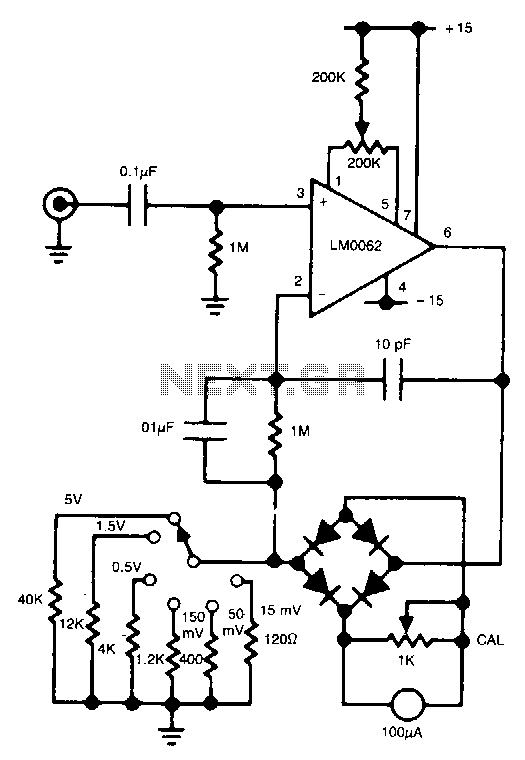
Wide-range-ac-voltmeter

In this circuit, a diode bridge is utilized as a meter rectifier. The offset voltage is compensated for by the operational amplifier, as the bridge is part of the feedback network.
The circuit employs a diode bridge rectifier, which consists of four diodes arranged in a bridge configuration. This setup allows for the conversion of alternating current (AC) to direct current (DC), making it suitable for applications such as power supply systems where a stable DC output is required.
The operational amplifier (op-amp) plays a crucial role in maintaining the accuracy of the output voltage by compensating for any offset voltage that may arise in the circuit. The op-amp is configured in a feedback loop with the diode bridge, enabling it to monitor the output voltage and adjust the input signal accordingly. This configuration enhances the precision of the rectified output, ensuring that variations in input voltage do not adversely affect the performance of the circuit.
The diode bridge's operation is characterized by its ability to allow current to flow in one direction while blocking it in the opposite direction. During the positive half-cycle of the AC input, two diodes conduct, allowing current to pass through to the output. Conversely, during the negative half-cycle, the other two diodes conduct, again directing current to the output. This alternating conduction effectively transforms the AC input into a pulsating DC output.
In summary, the integration of a diode bridge rectifier with an operational amplifier in the feedback network provides a robust solution for converting AC to DC while effectively managing offset voltages, resulting in a reliable and stable output suitable for various electronic applications.In this circuit, a diode bridge is used as a meter rectifier. The offset voltage is compensated for by the op amp, since the bridge is in the feedback network. 🔗 External reference
The circuit employs a diode bridge rectifier, which consists of four diodes arranged in a bridge configuration. This setup allows for the conversion of alternating current (AC) to direct current (DC), making it suitable for applications such as power supply systems where a stable DC output is required.
The operational amplifier (op-amp) plays a crucial role in maintaining the accuracy of the output voltage by compensating for any offset voltage that may arise in the circuit. The op-amp is configured in a feedback loop with the diode bridge, enabling it to monitor the output voltage and adjust the input signal accordingly. This configuration enhances the precision of the rectified output, ensuring that variations in input voltage do not adversely affect the performance of the circuit.
The diode bridge's operation is characterized by its ability to allow current to flow in one direction while blocking it in the opposite direction. During the positive half-cycle of the AC input, two diodes conduct, allowing current to pass through to the output. Conversely, during the negative half-cycle, the other two diodes conduct, again directing current to the output. This alternating conduction effectively transforms the AC input into a pulsating DC output.
In summary, the integration of a diode bridge rectifier with an operational amplifier in the feedback network provides a robust solution for converting AC to DC while effectively managing offset voltages, resulting in a reliable and stable output suitable for various electronic applications.In this circuit, a diode bridge is used as a meter rectifier. The offset voltage is compensated for by the op amp, since the bridge is in the feedback network. 🔗 External reference